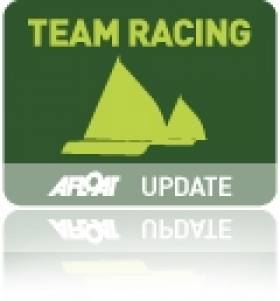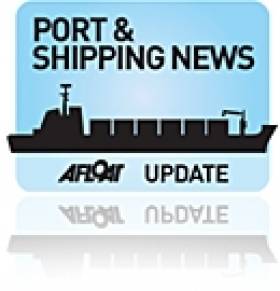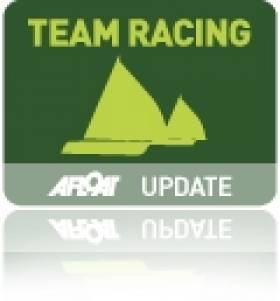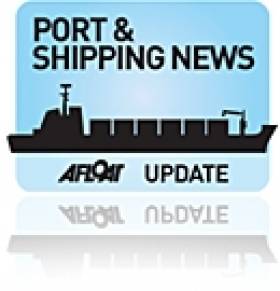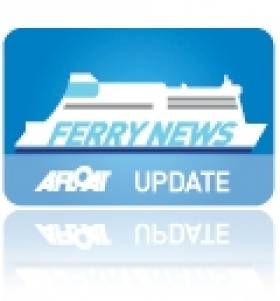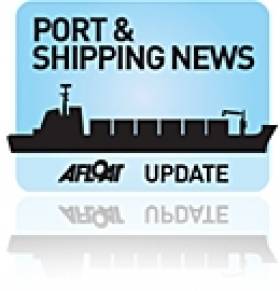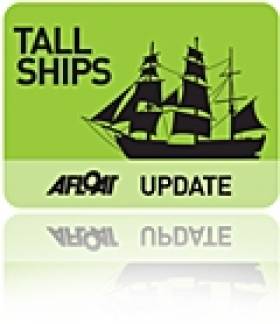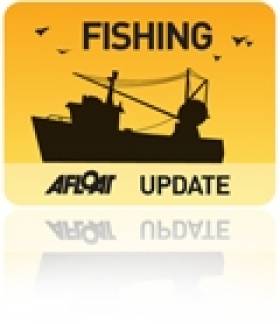Displaying items by tag: Galway
Calasantius College are Connaught Schools Team Sailing Champions
The title of Connaught Schools Team Sailing Champions went to Calasantius College, Oranmore last Saturday (16th April). PHOTOS BELOW. The winning team was made up of Rian Conboy, Cian Walsh, Cormac Furey, Rebecca Mullins, Jenny Carberry, Eoin Breen and David Carberry. Connaught school team entrants included last years Connaught Champions Rice College, Westport who were out in force to defend the title however they were knocked out early in the day. From Galway city were teams from St. Joseph's College, The Bish and Coláiste Éinde, (St. Enda's), and from the county were Scoil Chuimsítheach Chiaráin, Carraroe and Calasanctius College, Oranmore.
This event, sponsored by Yachtsman Euromarine and organised by Bow Waves Marine School was officially opened by Galway TD., Ciaran Cannon, Minister of State for Training and Skills at 9.30am at Bow Waves, in the Galway Ocean Sports Centre in Galway Harbour Enterprise Park. 'Here in Galway we are so lucky to be surrounded by water. Our young people need to be exposed to such leisure sports as sailing at an early age so as to cultivate a passion and respect for a healthy lifestyle and enjoyment of our waterways. Bow Waves provides an extensive portfolio of high quality marine training to all ages and I commend them for their efforts in developing the Connacht Championships here in Galway and all the efforts they are making for school goers to get involved in sailing,' said Mr. Ciaran Cannon, TD.
The first race began just after 10.00am on the course laid out in Lough Atalia making it very accessible for all to spectate and watch the skills of these young sailors. Seeing the dinghy sailing activity on the sparkling water with the sun shine is a great start to a summers activities. This unusual sight attracted the attention of Galwegians and visitors alike. Early in the day, the wind was very light making racing difficult however the wind picked up as the sun came out in the afternoon adding to the excitement of the day.
Ongoing Ferry Saga As Cargoship is Detained
Harbourmaster Capt. Brian Sheridan, confirmed yesterday evening that the Danish flagged vessel had been detained at lunchtime on the instructions of the admiralty marshal, a High Court judge, acting under maritime law. Until matters are resolved, a ship's keeper has been placed onboard by the Revenue Commissioners.
Rice College to Defend Connaught Schools Team Sailing Crown
The first race begins at 10.15am on the course laid out in Lough Atalia making it very accessible for all to spectate and watch the skills of these young sailors. Each school will have the opportunity to race against all other teams in a round robin series, followed by a semi-finals and a final heat. Viewing vantage points will be from Lough Atalia road and the balcony at the Radisson SAS hotel. This promises to be an action filled day with races running right into the evening.
Bow Waves is a leading watersports facility, based in the Galway Harbour Enterprise Development, running both leisure and commercial marine training courses year round. It was founded in 1996 by Finbarr O'Regan, a seasoned trainer, who has 20 years experience in marine, watersports and safety training.
"We've got the perfect location for sailing within the safe, sheltered waters of Lough Atalia. This is truly a one of kind sailing experience that will be both challenging and lots of fun for students,' O'Regan added.
'As a parent of three children, I see how important it is to sew the seeds early to develop an interest in healthy activities like sailing particularly in their teens,' said Finbarr O'Regan, 'by providing regional competitions like this, we assist children to look to the water as a great hobby and lifestyle into their adult years.' Finbarr and his wife Marguerite met through their involvement in watersports and decided to set up Bow Waves in Galway in the nineties as they settled down in the west of Ireland, having travelled the world with their common passion and interest. 'Our waterways, rivers and Galway Bay are fantastic natural amenities, how we use them and enjoy them can be greatly improved by starting children at a young age and can make a great difference to their future interests and a lifelong hobby,' commented Finbarr.
Cargoship to Attempt Second Ferry-Lift
In the first attempt to load the ferries last week, the Clann na nOileáin fell into the Dun Aengus Dock when the sling rope broke causing the French built 234-passenger craft to fall some 12m /40ft. Onboard the ferry were three people who were taken to hospital but were later released.
Thor Gitta is fitted with two deck-mounted cranes and this feature is also similarly found on the Patanal, which grounded in Casla Bay at the entrance to Rossaveal, nearly a fortnight ago. The German owned 7,002grt was the first vessel chartered to bring the fast-ferries from Rossaveal, but the ferries were subsequently sailed to Galway after the ship was refloated.
The 120m Patanal has undergone "underwater and internal inspections and repairs," according to Capt. Brian Sheridan, harbourmaster of Galway Port Company though he added "that the vessel would remain subject to an inspection by the Marine Survey Office before she can be released".
According to a statement released by the Patanal's owners, Harren & Partner, the vessel is then to be taken to dry dock in Bremerhaven for further repairs.
Since the incident the vessel has been at anchorage off Black Point on the Co. Clare side of Galway Bay where she was monitored initially for pollution and the tug Celtic Isle in attendance. The tug is operated by Celtic Tugs and is normally based in Foynes, Co. Limerick.
Ferry Falls from Crane in Galway Docks
An investigation is underway into an incident in Galway Docks this morning after a ferry being loaded onto a cargo ship snapped, injuring three men, according to news reports.
A sling that was being used to lift the ferry onto the cargo ship, snapped and the ferry fell 12 metres (40ft) into the water.
Three men have been taken to hospital. They were involved in the loading of a passenger ferry, Clann Na nOilean, onto a large ocean-going freight carrier in the harbour.
All further work on the removal of two passenger ferries at the docks has now been suspended. RTE News has a dramatic picture of the incident here.
Latest Ferry News
Latest Ports and Shipping News
Minister Coveney is meeting the Harbour Master and will be briefed by the various agencies who are involved in the operation, including the Irish Coast Guard, Galway County Council and the ship's representatives and will be given a full assessment of the current situation and the contingency arrangements being put in place by the agencies involved for the next few days.
The Minister said "I am anxious to see the situation for myself and to express my support to all involved in this multi-agency operation. While this is obviously a very serious and evolving situation, I have full confidence in the Harbour Master and his staff, the Coast Guard and the other agencies involved to do a fully professional job to address the current situation. The purpose of my visit is to reassure all those concerned that this incident is getting the priority it deserves. I am especially concerned to ensure that all appropriate measures are taken to protect the harbour and the local environment and to avoid any pollution during the very challenging efforts to refloat the vessel. "
The current situation and the weather forecast are being carefully monitored by the Coast Guard. Initial investigations, including evidence from divers, indicate no apparent damage to the vessel and no pollution has been reported. Meanwhile, the vessel's owners are in the process of organising tugs to help move it from its current position.
Tall Order for Ireland
Sailing in Ireland could yet have a tall ship to replace the Asgard II and the Lord Rank. A meeting in Dublin in late March represents a major step forward in the process to put an Irish tall ship back on the high seas.
The open workshop, to be held on March 26th, will be facilitated by Dublin Port, and will include state interests, tourism interests, commercial port interests, youth organisations, maritime organisations and education groups, together with the former Lord Rank and Asgard II operators.
The catalyst for the initiative is a 'reference group' which represents a broad cross-section of interests, both North and South. Operating under the chairmanship of Lord Glentoran, and supported by Dr Gerard O'Hare, David Beattie and Enda O'Coineen, the group has also engaged a professional consulting firm to move the process along.
The initial focus is on the necessary organisation and rationale behind building a new vessel, while scientifically quantifying the benefits to build a plan and justification.
The view taken is that, while there may be no money available at this time, there is no excuse for not having a plan and the idea is to create ' joined-up' thinking. And while the government in the South placed the insurance money paid out on Asgard II back into general exchequer funds, the insurance payment on the Lord Rank was kept and ' ring-fenced' for this new initiative.
To date, there have been several meetings of the reference group. The planned workshop on the subject at Dublin Port March 26 is open and interested parties are invited to contribute. It will also bring together for the first time the leaders of Tallships in Dublin, Belfast, Waterford and Cork.
Ultimately Tall Ships is about youth training and development; without an active Tall Ship, it will be very difficult for Ireland to attract Tall Ship events. The new reference group will work to support the new Sail Training Ireland Association initiative, and link in with Sail Training International which runs Tall Ship events.
Following the Dublin workshop, Belfast Harbour Commissioners will host a working meeting of the group in early May to finalise a plan, present to stakeholders and create a roadmap forward.
"In addition to youth training, a working Tall Ship forms a brilliant ambassadorial role promoting tourism, enterprise and commercial interests," said Lord Glentoran. "It is something that we can all relate to and it has universal acceptance for youth training on an island of Ireland basis." Lord Glentoran has a long commitment to youth sail training and was Chairman of the organising committee that brought the Tall Ships to Belfast in 1991.
The reference group is seeking to engage with as many stakeholders as possible, and has pledged that the new vessel will be owned by the community in Ireland and the Irish Diaspora. The initial view is that the project clearly needs to be linked with the institutions of State - North and South - as are universities state agencies and ports, while at the same time having a strong private support network making for a mix of public and private funding, "We now have a brilliant opportunity to look around the world, establish best practice in the best kind of vessel, how to fund it and to quantify the benefits for each of the stakeholder group," said Enda O'Coineen, who has been instrumental in bringing the group together. In addition to being a former Coiste and Asgard Director, he is the founding Chairman of Let's Do It Global, which brought the Volvo Ocean Race to Galway and successfully raced the Green Dragon around the world.
O'Coineen added that a "world class solution" can be created and that its benefits can be financially quantified, which would allow supporters to make a compelling business case to divert and use existing funds in Tourism, Enterprise and Youth Training. "While there is no money available now to support the scale and professionalism needed, this is not an excuse not to have a plan and a vision," he added.
Since the loss of the Asgard II and Lord Rank, Ireland has been left with no sail training opportunities for young people and likewise for maritime development, enterprise and tourism. If nothing is done, future generations will suffer. The reference group believes that the solution is the construction of an Ireland - North and South - training vessel, fulfilling several roles with a common mission and resourced according to quantifiable benefits delivered to stakeholders. It is also open to the use of an existing vessel - a key component being suitability and the operations budget.
The proposed Tall Ship project will enhance skills and opportunities for young people across the island, regardless of background, class or education. It could be used to showcase Ireland as a brand at overseas events and it could also host international students who wish to come to the island of Ireland, as is the case with many of the International Tall Ships Programmes already running on a global scale which create a huge amount of tourism for their respective countries.
The reference group notes that the Tall Ships concept appeals to young and old alike as the romanticism behind the concept touches on history, social studies, legacy, family, travel, adventure and, most importantly, fun. Tall Ships allow people to dream. They do however have an underlying seriousness and the concept is grounded in methodology that has been tested and proven the world over.
An advertisement in March/April of Afloat magazine - out now - gives full detials of the 'Tall Ship for Ireland' Workshop
Should Ireland be represented at the Tall Ships Races at Waterford 2011 and Dublin 2012? We want your vote on our Facebook Poll HERE.
Looking for further reading on Tall Ships in Ireland? Click the links below:
Click this link to read all our Tall Ships Stories on one handy page
Previewing Ireland's Tall Ships 2011 Season
Deadliest Catch Star Warns of Threat to Small-Boat Fishing
The Common Fisheries Policy will wipe out coastal communities in Ireland, according to a star of TV's Deadliest Catch.
Corey Arnold, who was in Galway today to speak at the Irish Skipper Expo, has spent time working with small-boat fishermen in Donegal and Mayo as part of a Pew Environment Group project to document the state of Europe's fishing industry.
He told The Irish Times: “It struck me that these people have a great opportunity to land top quality, sustainably caught fish, but they get no real encouragement under current management policies."
Arnold emphasised that smaller boats "barely get enough quota to survive, compared to the much larger vessels which get most of the quotas and can discard up to 50 per cent of their catch.”
The American, who is a photographer and seasoned salmon and crab fisherman, said fishery management practice in Alaska offered lessons for Europe.
Cruise from Kinvara to Tahiti Wins Sailor of the Month Award
Recognised by the senior offshore sailing organisation, the Irish Cruising Club, with the award of the historic Faulkner Cup, the Quinlan's achievement is further enhanced by the fact that, in their determination to acquire a boat suitable for long distance voyaging, they built their steel-constructed 40ft cutter Pylades themselves, launching in 1997.

They have brought a lively and enquiring eye to the complex project, something which reflects Fergus's qualifications as an architect. As he has drily observed himself, there isn't a lot of work around for architects in Ireland at the moment, so everything clicked with the boat sea-tested and ready to go off on this sail of a lifetime.
Having left Kinvara in June 2009, their longterm plan is a global circumnavigation, returning to Galway Bay in August 2012. Quite what Ireland will be like by then is anybody's guess. But as it is, the crew of Pylades have enough to be getting on with in dealing with the vagaries of the open ocean, and the volatile political situation in some of the areas where ocean voyagers go. For armchair sailors at home, their thoughtful and entertaining reports on their experiences make them worthy "Sailors of the Month".
New Sports Centre To Provide Greater Access to Galway Bay
This weekend sees the opening of the new Galway Ocean Sports Centre, which aims to provide a home for water sports enthusiasts with access to the city and Galway Bay.
The Galway City Tribune reports that the 25,000 sq ft premises will provide facilities for up to 20 clubs and organisations in the city, with meeting rooms, showers and space for equipment storage.
"The big thing about this is that it will make water sports more accessible to children and adults,” said centre co-ordinator Johnny Murphy.
The Galway City Tribune has more on the story HERE.


























